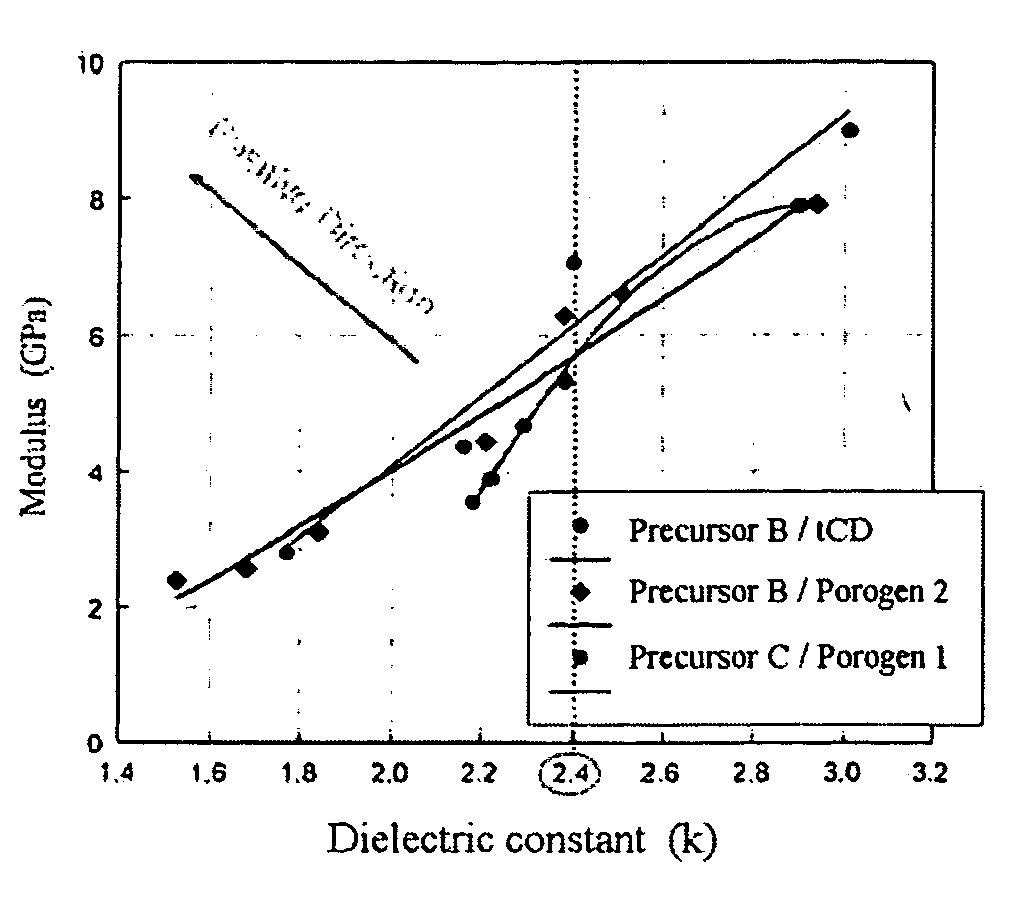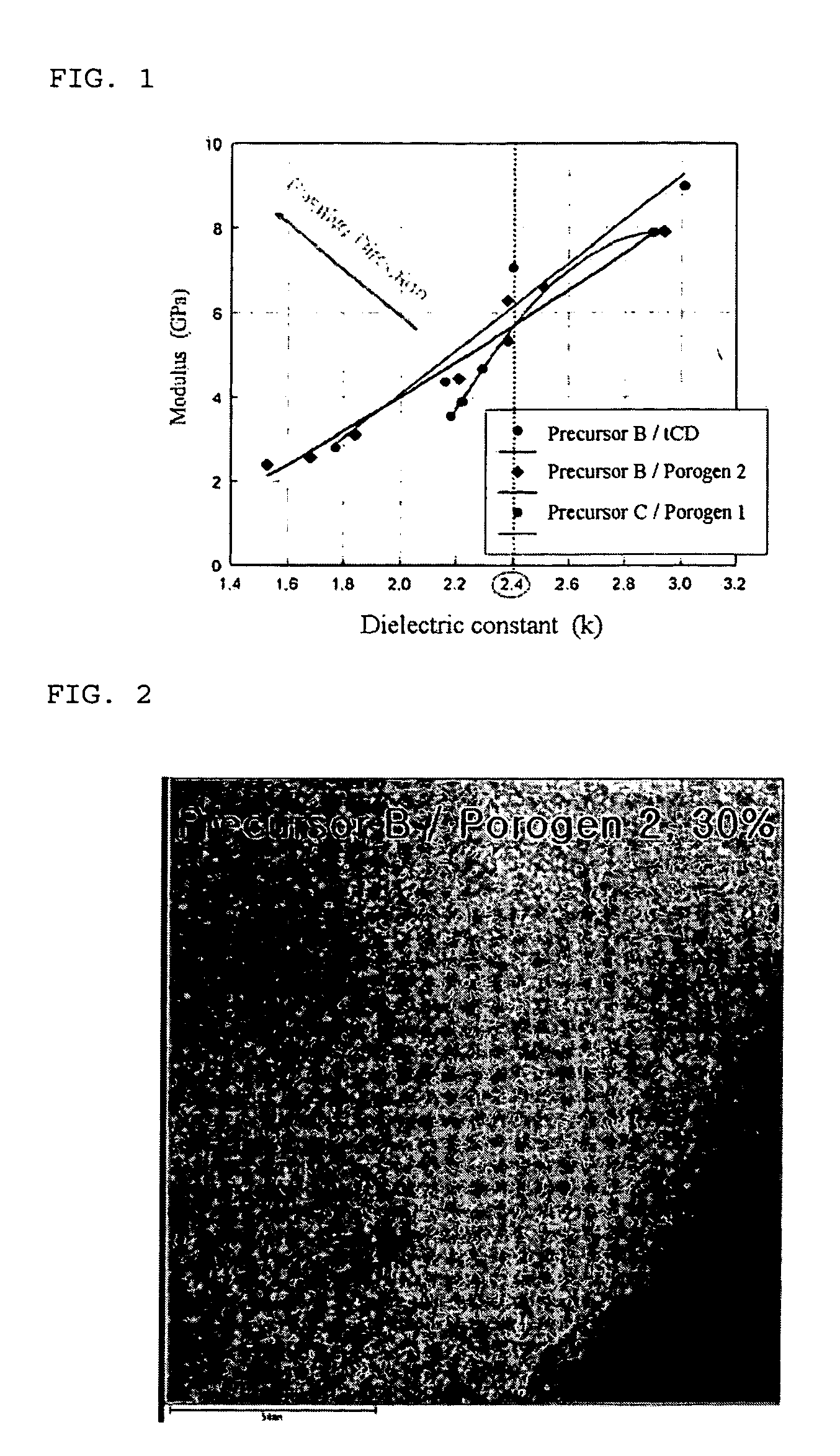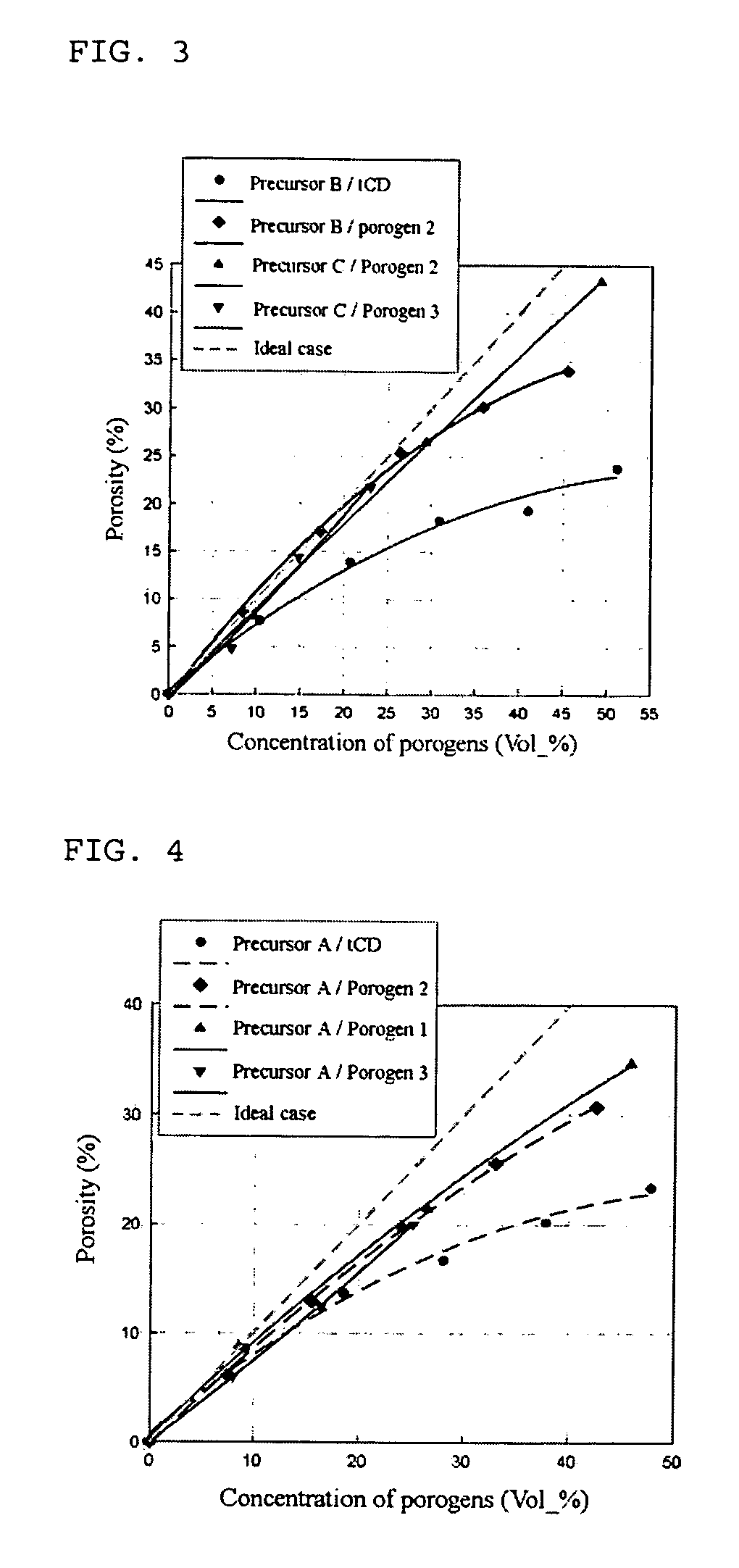Composition for preparing nanoporous material
a nanoporous material and nanoporous technology, applied in the field of composition for preparing nanoporous materials, can solve the problems of insufficient dielectric constant range to meet an increasing demand, large pores as large as 50 100 , uneven distribution of pores in the matrix, so as to achieve superior mechanical properties, increase molecular volume, and improve the stability of pores
- Summary
- Abstract
- Description
- Claims
- Application Information
AI Technical Summary
Benefits of technology
Problems solved by technology
Method used
Image
Examples
example 1
Synthesis of Matrix Monomers
EXAMPLE 1-1
Synthesis of Monomer “a”
[0070] To a flask were added 29.014 mmol (10.0 g) of 2,4,6,8 -tetramethyl-2,4,6,8-tetravinylcyclotetrasiloxane and a solution of 0.164 g of platinum(0)-1,3-divinyl-1,1,3,3-tetramethyldisiloxane complex in xylenes, and then diluted in 300 ml of diethyl ether. After the reaction solution was cooled to −78° C., 127.66 mmol (17.29 g) of trichlorosilane was slowly added thereto. The reaction temperature was gradually raised to room temperature. At this temperature, the reaction was continued for 40 hours. The reaction solution was concentrated at a reduced pressure (˜0.1 torr) to completely remove volatile substances, and then 100 ml of hexane was added to the concentrate. The resulting mixture was stirred for 1 hour and filtered through celite to obtain a colorless clear solution. The hexane was evaporated at a reduced pressure (˜0.1 torr) to obtain a reaction product as a liquid.
[0071] Next, 11.56 mmol (10.0 g) of the re...
example 1-2
Synthesis of Monomer “b”
[0073] A solution of 21.4 mmol (3.8 g) of palladium (II) dichloride [PdCl2(II)] in 50 ml of carbon tetrachloride was placed in a flask, and then 41.6 mmole (10.00 g) of 2,4,6,8-tetramethyl-2,4,6,8-cyclotetrasiloxane was slowly added thereto. The mixture was allowed to react at room temperature for about 10 minutes. The reaction mixture was filtered through celite and MgSO4. Thereafter, the obtained filtrate was diluted in 200 ml of tetrahydrofuran, and then 183.0 mmol (18.5 g) of triethylamine was added thereto. The resulting mixture was stirred at room temperature for 10 minutes, and then an excess of methyl alcohol (366.1 mmol (11.7 g)) was added thereto. The resulting mixture was reacted for 5 hours. The reaction solution was filtered through celite, and the filtrate was concentrated at a reduced pressure (˜0.1 torr) to remove volatile substances, affording monomer “b” represented by the following formula:
[0074] The analytical results of the 1H-NMR spect...
example 2
Preparation of Matrix Precursors
[0075] Precursor A: Copolymerization of monomer “a” and methyltrimethoxysilane (MTMS)
[0076] After 37.86 mmol (5.158 g) of methyltrimethoxysilane and 3.79 mmol (3.162 g) of the monomer “a” prepared in Example 1-1 were charged into a flask, the mixture was diluted in 100 ml of tetrahydrofuran. Separately, water and concentrated hydrochloric acid (containing 35% hydrogen chloride) were mixed in a ratio of 100:0.12 (v / v) to prepare a hydrochloric acid in which the hydrogen chloride was present in an amount of 0.0159 mmol. The hydrochloric acid was slowly added to the previous mixture, and then water was slowly added thereto until the total amount of water, including water contained in the hydrochloric acid, reached 529.67 mmol (9.534 g). The reaction temperature was gradually increased to 70° C. At this temperature, the reaction was continued for 16 hours. The reaction solution was transferred to a separatory funnel, and then 100 ml of diethyl ether was...
PUM
| Property | Measurement | Unit |
|---|---|---|
| dielectric constant | aaaaa | aaaaa |
| dielectric constant | aaaaa | aaaaa |
| dielectric constant | aaaaa | aaaaa |
Abstract
Description
Claims
Application Information
 Login to View More
Login to View More - R&D
- Intellectual Property
- Life Sciences
- Materials
- Tech Scout
- Unparalleled Data Quality
- Higher Quality Content
- 60% Fewer Hallucinations
Browse by: Latest US Patents, China's latest patents, Technical Efficacy Thesaurus, Application Domain, Technology Topic, Popular Technical Reports.
© 2025 PatSnap. All rights reserved.Legal|Privacy policy|Modern Slavery Act Transparency Statement|Sitemap|About US| Contact US: help@patsnap.com



